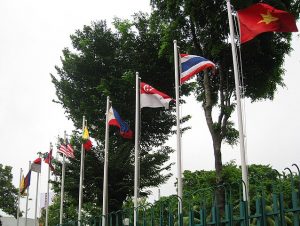On May 7, 2020, the first issue of The ASEAN magazine was released to the public, with the objective of informing citizens of the work of the Association of Southeast Asian Nations. On this remarkable occasion, this article looks into the past, present, and future of regional integration in Southeast Asia from a youth perspective. A highly-integrated ASEAN in the distant future might mean an eventual departure from the noninterference principle.
The ASEAN is a monthly publication by the ASEAN Secretariat. The idea of the magazine was first conceived in 2019, in line with the campaign for 2020 as the Year of ASEAN Identity. In the first issue — “A Shared Identity – Becoming ASEAN” — Secretary-General Dato Lim Jock Hoi writes that it is their aspiration for The ASEAN to reach audiences beyond the region. This is reaffirmed by Indian Ambassador Rudrendra Tandon, who suggested that the magazine “can also serve to bring ASEAN out of the shadows for audiences in the wider international community.” As such, the significance of this magazine lies not only in the consolidation of an ASEAN identity within the region, but also in displaying ASEAN unity to the rest of the world.
The tragedy of Brexit proves that institutional integration is unsustainable if not supported by sociocultural integration. With Southeast Asia being such a diverse region, it makes sense that ASEAN integration is heralded by efforts promoting the ASEAN Identity. In some sense, however, this entails undoing ASEAN’s previous narratives.
The final preamble of the 1967 Bangkok Declaration shows that one of ASEAN’s early purposes was to protect the sovereignty of the then-fledgling nation states. For example, the concept of an Indonesian state or the Philippines hardly existed before the arrival of the European colonists. As they took power, the governments of these nascent states struggled to create their brands of nationalism. The Southeast Asian borderlands were especially problematic as the Europeans disregarded the existing ethnic communities in carving up the colonies, leading to tensions such as Sukarno’s Konfrontasi and conflicts between Malaysia and the Philippines over Sabah.
As such, ASEAN cemented its noninterference principle, which is by far the most well-known tenet of the “ASEAN Way.” ASEAN began as an organization for coexistence rather than cooperation. Thus it is unsurprising that contacts were minimal, with only three summits held in the first two decades.
Eventually, government interactions under the ASEAN framework flourished. The current ASEAN Emblem was adopted in 1997, and 2007 marked a major milestone for the regional bloc — the ASEAN Charter was signed by all heads of states at the 13th ASEAN Summit, conferring legal personality. The ASEAN Community was launched in 2015, with the Political-Security, Economic, and Socio-Cultural pillars.
The current generation grew up seeing ASEAN on the headlines all the time, watching ASEAN leaders lined up for pictures in the signature handshake. For the most part, ASEAN feels like something distant — discourses between governments that hardly affect individuals at a personal level, even if citizens vaguely know that they are a part of a wider regional community.
A strong ASEAN identity provides the basis for institutional integration. Many entities have strived to nurture a new generation for whom ASEAN is a synonym for regional identity, an ASEAN that brings peace and prosperity to its people. The ASEAN Foundation was established on ASEAN’s 30th anniversary, to promote “awareness, identity, interaction and development” of the people of ASEAN. The Indonesian foreign ministry, for example, has its Duta Muda ASEAN Indonesia program, in which young ambassadors are selected to promote the regional organization across the country.
Greater regional unity means that Southeast Asian citizens no longer see each other only as neighbors, but as family. And family members are supposed to care for one another. They help each other out in times of need; they also point out each other’s mistakes, even when it is a bitter pill to swallow.
Greater integration necessarily entails more interference. Whether this is an intended outcome or not, greater sociocultural integration in the ASEAN region will inevitably entail much more discourse on domestic politics within other regional countries. While it is unlikely that governments will start actively commenting on one another’s domestic politics anytime soon, it is likely that there will be a proliferation of alliances between the civil societies of ASEAN member states. The future ASEAN citizens shall care for each other as they would for their own fellow citizens; the future ASEAN leaders shall be keeping each other in check to ensure a peaceful and prosperous Southeast Asia.
The ASEAN Way will evolve, and in this process the age-old notion of noninterference would eventually have to be reconsidered. Sociocultural integration today is the vanguard of institutional integration tomorrow. Tomorrow’s ASEAN must be united on the inside, strong on the outside; today’s ASEAN is of our governments; tomorrow’s ASEAN will be of the people.
Truston Yu is a research assistant at the Department of Politics and Public Administration, the University of Hong Kong and is currently based in Seoul. Their primary interests are in Southeast Asian studies and international law. Truston is also a contributor to the Jakarta Post.

































